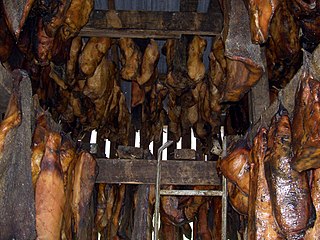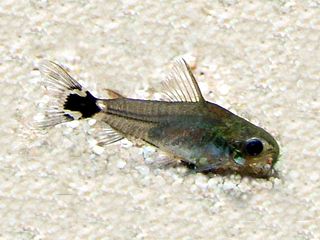
Callichthyidae is a family of catfishes, called armored catfishes due to the two rows of bony plates along the lengths of their bodies. It contains some of the most popular freshwater aquarium fish, such as many species in the genus Corydoras.

Corydoras is a genus of freshwater catfish in the family Callichthyidae and subfamily Corydoradinae. The species usually have more restricted areas of endemism than other callichthyids, but the area of distribution of the entire genus almost equals the area of distribution of the family, except for Panama where Corydoras is not present. Corydoras species are distributed in South America where they can be found from the east of the Andes to the Atlantic coast, from Trinidad to the Río de la Plata drainage in northern Argentina. Species assigned to Corydoras display a broad diversity of body shapes and coloration. Corydoras are small fish, ranging from 2.5 to 12 cm in SL., and are protected from predators by their body armor and by their sharp, typically venomous spines.

The bronze corydoras, also known as the green corydoras, bronze catfish, lightspot corydoras or wavy catfish, is a species of freshwater fish in the armored catfish family, Callichthyidae, often kept as an aquarium fish. It is widely distributed in South America on the eastern side of the Andes, from Colombia and Trinidad to the Río de la Plata basin; however, as presently defined it is a species complex and a taxonomic review is necessary. It was originally described as Hoplosoma aeneum by Theodore Gill in 1858 and has historically also been referred to as Callichthys aeneus.

Sterba's corydoras is a member of the South American Corydoras genus of freshwater aquarium catfish and one of the most popular species of Corydoras due to its attractive markings. The fish is native to the Guaporé River region between Bolivia and Brazil.

The Greenland shark, also known as the gurry shark or grey shark, is a large shark of the family Somniosidae, closely related to the Pacific and southern sleeper sharks. Inhabiting the North Atlantic and Arctic Oceans, they are notable for their exceptional longevity, although they are poorly studied due to the depth and remoteness of their natural habitat.

Hákarl, referred to as fermented shark in English, is a national dish of Iceland consisting of Greenland shark or other sleeper shark that has been cured with a particular fermentation process and hung to dry for four to five months. It has a strong ammonia-rich smell and fishy taste, making hákarl an acquired taste.

Corydoras panda is a species of catfish belonging to the genus Corydoras, of the family Callichthyidae, and is a native member of the riverine fauna of South America. It is found in Peru and Ecuador, most notably in the Huánuco region, where it inhabits the Río Aquas, the Río Amarillae, a tributary of the Río Pachitea, and the Río Ucayali river system. The species was first collected by Randolph H. Richards in 1968, and was named Corydoras panda by Nijssen and Isbrücker in 1971. The specific name is an allusion to the appearance of the fish, which possesses large black patches surrounding the eyes, reminiscent of those found on the giant panda. Accordingly, the common names for this fish, which is a popular aquarium species, are panda corydoras and panda catfish.

The dwarf corydoras, dwarf catfish, tail spot pygmy catfish, or micro catfish is a tropical freshwater fish belonging to the subfamily Corydoradinae of the family Callichthyidae. It originates in inland waters in South America, and is found in the Amazon River and Paraguay River basins in Argentina, Bolivia, and Brazil. The specific epithet hastatus means with a spear, in reference to the spearhead-like spot on the tail root.

The masked corydoras, bandit catfish, bandit corydoras, or Meta River corydoras is a tropical freshwater fish belonging to the Corydoradinae sub-family of the family Callichthyidae. It originates in inland waters of South America, and is found in the Meta River basin in Colombia. A maximum length of 4.8 cm has been recorded.

Corydoras reticulatus, also called the reticulated corydoras, mosaic corydoras, network catfish, or network corydoras, is a tropical freshwater fish belonging to the Corydoradinae sub-family of the family Callichthyidae. It originates in inland waters in South America, and is found in the Lower Amazon River basin in Brazil.
The Xingu corydoras is a tropical freshwater fish belonging to the subfamily Corydoradinae of the family Callichthyidae. It originates in inland waters in South America, and is found in the upper Xingu River basin in Brazil. It is named for the river in which it is found. In the system of "C-Numbers" developed by the German fishkeeping magazine DATZ to identify undescribed species of Corydoras in the aquarium hobby, this fish had been assigned numbers "C55", "C105", "C106", "C107", and "C108" until these were correctly identified.

Somniosus is a widely distributed genus of deepwater dogfish sharks in the family Somniosidae. Several members of the genus are believed to attain lengths up to 7 m (23 ft), thus ranking among the largest of sharks.

Corydoras julii is a small freshwater catfish native to eastern Brazil. It is often confused with Corydoras trilineatus, the three stripe corydoras. Corydoras julii are small, peaceful shoaling fish, and are typically kept in groups in captivity.

Dendropsophus microcephalus is a species of frog in the family Hylidae. It is found in southeastern Mexico, Central America, and northern South America in Colombia, Venezuela, Trinidad and Tobago, the Guianas, and northern Brazil. This widespread species might actually be a species complex. Its common names include yellow treefrog, small-headed treefrog, and yellow cricket treefrog.

The southern sleeper shark, or Whitley's sleeper shark, is a deepwater benthopelagic sleeper shark of the family Somniosidae found in the southern and subantarctic extremes of the Atlantic, Indian and Pacific Oceans, and some northern reaches of the Antarctic oceans. It has been recorded near the southernmost areas of South America, near South Africa, southern Australia, Tasmania and New Zealand, as well as more remote locations in the south-central Indian Ocean.
Han Nijssen was a Dutch ichthyologist.

Ian Alexander McDonald Fuller is an English aquarist and ichthyologist.














